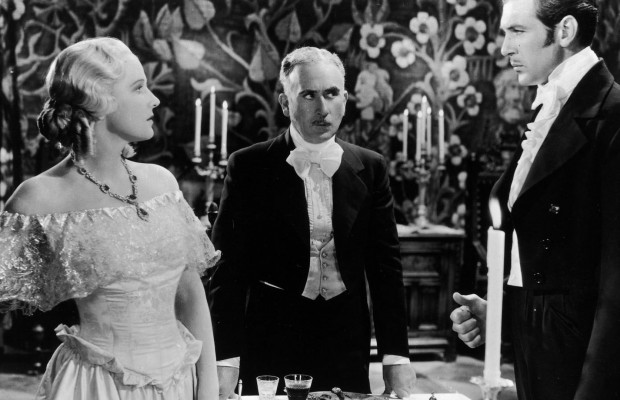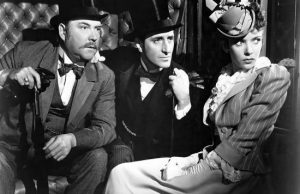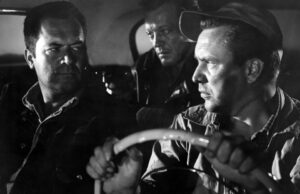Peter Ibbetson (1935)

Toronto Film Society presented Peter Ibbetson on Sunday, February 9, 2014 in a double bill with I’ll Never Forget You, as part of the Season 66 Sunday Afternoon Film Buff Series, Programme 5.
This very unusual film was a remake of a 1921 silent that starred ’20s heartthrob Wallace Reid. Its director comes as a surprise–tough, no-nonsense Henry Hathaway, best remembered  today for westerns such as The Sons of Katie Elder (1965), Nevada Smith (1966) and True Grit (1969) and gripping noirs such as Kiss of Death (1947) and Niagara (1953). Though Paramount’s leading male star Gary Cooper felt he was miscast in the film’s title role, Hathaway disagreed. He liked Cooper’s quietly understated style, and later remarked that “Gary Cooper was the first actor to believe you didn’t have to mug to act. If you thought of what you were doing, it showed–and he proved he was right.”
today for westerns such as The Sons of Katie Elder (1965), Nevada Smith (1966) and True Grit (1969) and gripping noirs such as Kiss of Death (1947) and Niagara (1953). Though Paramount’s leading male star Gary Cooper felt he was miscast in the film’s title role, Hathaway disagreed. He liked Cooper’s quietly understated style, and later remarked that “Gary Cooper was the first actor to believe you didn’t have to mug to act. If you thought of what you were doing, it showed–and he proved he was right.”
The film’s leading lady, ethereal ANN HARDING, is almost unknown today. The “army brat” daughter of a Brigadier General who grew up on U.S. Army bases all over the United States and Cuba, she was a gentle, refined actress whose movie career came and went through various phases. When the advent of talking films brought a demand in Hollywood for stage actors, Broadway star Harding was hired by Pathe Studios in 1929. She never quite fit into the Hollywood glamour mode. Unlike most film stars of the period, Ann dressed down off-camera, with little concern for her appearance. She even attended premieres without studio makeup, costuming or hair-dos–leading gossip writer Adela Rogers St. John to dub Harding “the worst dressed woman I ever saw in my life!” But serious, calm Ann was in it for the work, not the glitz: “I believe that the actress who wears her profession on her sleeve, as it were, outside of work, is, as a rule, merely dramatizing herself,” she observed. “When she acts off-stage as well as on, she is wasting her talent. It is like using nectar to quench a casual thirst.”
Her first starring roles were all much the same, and by 1933 her initial popularity waned. She quit films in 1937, after marrying conductor Warner Janssen, but returned in 1942 to play  more mature character parts. With Ann’s refreshing lack of vanity, she never shied away from playing older love interests, or mothers. Some of her roles were, indeed, surprisingly mature. In 1947’s Christmas Eve, she played the adoptive mother of George Raft, George Brent and Randolph Scott, though she was years younger than both Brent and Scott, and she and Raft were born the same year. In 1950, she again took a five-year break to concentrate on stage and television work. She returned to Hollywood to make a handful of films, including The Man in the Gray Flannel Suit (1956), but ultimately chose to focus on her busy television career. She died at 80, in 1981.
more mature character parts. With Ann’s refreshing lack of vanity, she never shied away from playing older love interests, or mothers. Some of her roles were, indeed, surprisingly mature. In 1947’s Christmas Eve, she played the adoptive mother of George Raft, George Brent and Randolph Scott, though she was years younger than both Brent and Scott, and she and Raft were born the same year. In 1950, she again took a five-year break to concentrate on stage and television work. She returned to Hollywood to make a handful of films, including The Man in the Gray Flannel Suit (1956), but ultimately chose to focus on her busy television career. She died at 80, in 1981.
Most Hollywood child actors of the early-to-mid-’30s were dimpled, sweet darlings, though some (notably Jane Withers) could also play memorable brats. But this film required something more–for the pivotal roles of Mimsey and Gogo, convincingly thoughtful and stubborn child actors were needed, or the plot just wouldn’t work. Paramount turned to two of the most talented kids in Hollywood for the task: Dickie Moore and Virginia Weidler.
DICKIE MOORE made his screen debut at 11 months, playing John Barrymore as a baby in 1927’s The Beloved Rogue. The very attractive little boy soon became one of Hollywood’s  busiest children; by age ten he had appeared in 52 movies, often (as when playing Marlene Dietrich’s son in 1932’s Blonde Venus) in major roles. Today, he is one of the few surviving members of the Our Gang comedy shorts. By the time Moore quit acting, at age 29, he had made well over 100 films. Along the way, in 1942, he gave Shirley Temple her first screen kiss in Miss Annie Rooney (a much-publicized experience he found most embarrassing, since it was also the first time he had ever kissed any girl, under any circumstances!) He served in World War II, then studied journalism in college. In 1949, Moore earned an Oscar nomination after producing and starring in The Boy and the Eagle, a live-action short about a handicapped boy’s relationship with a wounded bird. He accepted the post of public relations director for Actors Equity in 1957, and also edited their magazine. In 1964, he formed his own public relations firm, Dick Moore Associates, and later successfully branched out to produce industrial films.
busiest children; by age ten he had appeared in 52 movies, often (as when playing Marlene Dietrich’s son in 1932’s Blonde Venus) in major roles. Today, he is one of the few surviving members of the Our Gang comedy shorts. By the time Moore quit acting, at age 29, he had made well over 100 films. Along the way, in 1942, he gave Shirley Temple her first screen kiss in Miss Annie Rooney (a much-publicized experience he found most embarrassing, since it was also the first time he had ever kissed any girl, under any circumstances!) He served in World War II, then studied journalism in college. In 1949, Moore earned an Oscar nomination after producing and starring in The Boy and the Eagle, a live-action short about a handicapped boy’s relationship with a wounded bird. He accepted the post of public relations director for Actors Equity in 1957, and also edited their magazine. In 1964, he formed his own public relations firm, Dick Moore Associates, and later successfully branched out to produce industrial films.
Considering his childhood career, Moore once remarked, “People have a tendency to remember you as you were. Unless you’re careful, you have a tendency to remember you as you were, too.” In 1984, he wrote the excellent book, Twinkle, Twinkle Little Star (But Don’t Have Sex or Take the Car) in which he interviewed 31 other former child actors and chronicled the (often rocky) directions their lives had taken. In 1981, while conducting interviews for the book, Moore met former MGM singing child star Jane Powell for the first time; they fell in love, and married in 1988. The couple are good friends of Turner Classic Movies host  Robert Osborne, and have both appeared in interviews about their careers on TCM. In 1999, he produced another book, Opportunities in Acting Careers with a foreword by his good friend Roddy McDowall. As he cannily observed, actors cannot always secure jobs in movies, on stage or on TV, and need to find other avenues in which to use the skills they have acquired: “I think performers have a real need to be made aware of the fact that their gifts and talents have a residual use. I’m always interested in anybody’s story where they have managed to beat the odds and come out doing something they want to do, and still be able to utilize their backgrounds. It’s worked for me.”
Robert Osborne, and have both appeared in interviews about their careers on TCM. In 1999, he produced another book, Opportunities in Acting Careers with a foreword by his good friend Roddy McDowall. As he cannily observed, actors cannot always secure jobs in movies, on stage or on TV, and need to find other avenues in which to use the skills they have acquired: “I think performers have a real need to be made aware of the fact that their gifts and talents have a residual use. I’m always interested in anybody’s story where they have managed to beat the odds and come out doing something they want to do, and still be able to utilize their backgrounds. It’s worked for me.”
VIRGINIA WEIDLER–normally a pigtailed brunette, but here a blonde to match Ann Harding’s colouring–was one of Hollywood’s most talented and reliable youngsters. But her career was almost over before it began; in her debut, cast in a small role at age 3 in John Barrymore’s Moby Dick (1930), she balked at removing her dress in front of the camera and lost the job. She later recalled a time inexperience caused her a brief bit of trouble: “I almost got fired the first day from Mrs. Wiggs of the Cabbage Patch (1934). They said I had to wink and I didn’t know how to wink.” But such lapses were rare; “Ginny” Weidler was a born character actress, blessed with a delightfully knowing way with a comic line, and the intelligence and sensitivity to handle dramatic ones. One of Virginia’s earliest directors knowingly predicted that the precocious girl would never become a major juvenile star: “All she can do is act.”
She was one of six children born in 1927 into a musical family of German immigrants. Her father, an architect, worked making models for 20th Century-Fox, and her mother was a  retired opera singer. Her older brothers included musicians George Weidler, Warner Weidler and Walter Weidler, and her older sister was band singer Renee Wild. It was not musical talent, but Virginia’s ability to speak French that first won her a contract at age 4 with RKO in 1931. After a period spent working at Paramount, she signed on with MGM in 1938. There, she capably held her own teamed with the often-overwhelming Mickey Rooney in several films: Love is a Headache, Out West with the Hardys (both 1938) and Young Tom Edison (1940). But MGM’s interest in her waned after they signed teenaged Shirley Temple to a contract in 1941 (ultimately, Temple ended up making only one film for them). Virginia was never a great beauty, and she became a rather awkward adolescent. She left Hollywood to tour successfully in vaudeville, using her song-and-dance skills as well as her great gift for mimicry. After World War II, she retired to marry naval officer Lionel Krisel and raised two sons–Ronnie and Gary (named after her two favourite actors, Colman and Cooper). When asked about her career in her later years, Lionel said Virginia “would always change the subject as quickly as possible without being rude. She never watched her old movies or replied to requests for interviews. Although she was never one to criticize, I think our boys got the impression that their mother didn’t think very much of the motion picture industry.”
retired opera singer. Her older brothers included musicians George Weidler, Warner Weidler and Walter Weidler, and her older sister was band singer Renee Wild. It was not musical talent, but Virginia’s ability to speak French that first won her a contract at age 4 with RKO in 1931. After a period spent working at Paramount, she signed on with MGM in 1938. There, she capably held her own teamed with the often-overwhelming Mickey Rooney in several films: Love is a Headache, Out West with the Hardys (both 1938) and Young Tom Edison (1940). But MGM’s interest in her waned after they signed teenaged Shirley Temple to a contract in 1941 (ultimately, Temple ended up making only one film for them). Virginia was never a great beauty, and she became a rather awkward adolescent. She left Hollywood to tour successfully in vaudeville, using her song-and-dance skills as well as her great gift for mimicry. After World War II, she retired to marry naval officer Lionel Krisel and raised two sons–Ronnie and Gary (named after her two favourite actors, Colman and Cooper). When asked about her career in her later years, Lionel said Virginia “would always change the subject as quickly as possible without being rude. She never watched her old movies or replied to requests for interviews. Although she was never one to criticize, I think our boys got the impression that their mother didn’t think very much of the motion picture industry.”
 Weidler was a lifelong friend of actress Jean Porter, her co-star in 1943’s The Youngest Profession. In a recent edition of Classic Images magazine, Porter recalled that when she and her husband, Canadian-born blacklisted director Edward Dmytryk, were ostracized in Hollywood, Virginia remained their loyal friend. The Dmytryks lived side by side with Virginia and her family, sharing their duplex. Porter also spoke of the Weidler family’s strong Christian Science beliefs, which she suspects contributed to Virginia’s early death, at 41, of a heart attack. This was an outcome of rheumatic fever Virginia contracted as a child.
Weidler was a lifelong friend of actress Jean Porter, her co-star in 1943’s The Youngest Profession. In a recent edition of Classic Images magazine, Porter recalled that when she and her husband, Canadian-born blacklisted director Edward Dmytryk, were ostracized in Hollywood, Virginia remained their loyal friend. The Dmytryks lived side by side with Virginia and her family, sharing their duplex. Porter also spoke of the Weidler family’s strong Christian Science beliefs, which she suspects contributed to Virginia’s early death, at 41, of a heart attack. This was an outcome of rheumatic fever Virginia contracted as a child.
Notes by Paddy Benham










We at the Virginia Weidler Remembrance Society take offence at the word “awkward”.
http://virginiaweidler.net/post/83608797433/why-ginnyfan-hates-mgm-or-learning-to-battle-the-a